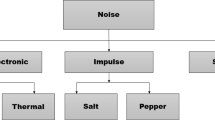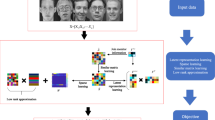Abstract
Dictionary learning has shown its effectiveness in computer vision with the concise expression form but the powerful representation. Dictionary learning represents images with a bag of visual words (BoVW), which is a collection of atoms expressively representative for images. Recently, several task-specific dictionary learning methods have been proposed and successfully applied in medical image analysis, such as de-noising, classification, segmentation, and so on, which promotes the development of computer-aided diagnosis. In this paper, first we give a survey for dictionary learning-based medical image analysis methods including: (1) three discriminative dictionary learning frameworks, (2) CT image de-noising based on dictionary learning, and (3) histopathological image classification using sparse representation. Then, a novel method named Low-rank Shared Dictionary Learning (LRSDL), is presented to achieve accurate glaucoma diagnosis on fundus images. The LRSDL generates a shared codebook for image reconstruction and a particular one to handle the difference between the healthy and glaucomatous images. Benefit from this strategy, LRSDL not only possess distinct glaucoma-related features, but also share common patterns among all the fundus images. Experimental results show that the method effectively delivers glaucoma diagnosis with the accuracy of 92.90%. This endows dictionary learning method a great potential for glaucoma diagnosis and proves the feasibility of its application to medical image analysis.



Similar content being viewed by others
References
Khan A, Doucette JA, Cohen R, Lizotte DJ (2012) Integrating machine learning into a medical decision support system to address the problem of missing patient data. In: 2012 11th international conference on machine learning and applications, Boca Raton, FL, pp 454–457
Seixas JL, Barbon S, Mantovani RG (2015) Pattern recognition of lower member skin ulcers in medical images with machine learning algorithms. In: 2015 IEEE 28th international symposium on computer-based medical systems, Sao Carlos, pp 50–53
Mothkur R, Km P (2018) Machine learning will transfigure medical sector: a survey. In: 2018 international conference on current trends towards converging technologies (ICCTCT), Coimbatore, pp 1–8
Song L, Peng J (2012) Dictionary learning research based on sparse representation. In: 2012 international conference on computer science and service system, Nanjing, pp 14–17
Zhang CZ, Zhao L (2011) Image de-noising based on learned dictionary. In: 2011 International conference on multimedia technology, Hangzhou, pp 3101–3104
Yu F, Chen Y, Luo L (2013) CT image denoising based on sparse representation using global dictionary. In: 2013 ICME International conference on complex medical engineering, Beijing, pp 408–411
Chen Y, Yin X, Shi L et al (2013) Improving abdomen tumor low-dose CT images using a fast dictionary learning based processing. Phys Med Biol 58:5803–5820
Shi L, Chen Y, Shu H, Luo L, Toumoulin C, Coatrieux J (2014) Low-dose CT image processing using artifact suppressed dictionary learning. In: 2014 IEEE 11th international symposium on biomedical imaging (ISBI), Beijing 2014, pp 1127–1130
Shan B, Hao W, Zhao R (2012) Infrared image de-noising based on K-SVD over-complete dictionaries learning. In: 2012 5th international congress on image and signal processin, Chongqing 2012, pp 316–320
Ji J, Ren F, Ji H, Yao Y, Hou G (2018) Generalised non-locally centralised image de-noising using sparse dictionary. IET Image Process 12(7):1072–1078
Vu TH, Mousavi HS, Monga V, Rao G, Rao UKA (2016) Histopathological Image Classification Using Discriminative Feature-Oriented Dictionary Learning. IEEE Trans Med Imaging 35(3):738–751
Liu M et al (2011) Sparse classification for computer aided diagnosis using learned dictionaries. Proc Med Image Comput Comput Assist Interv (MICCAI) 6893:41–48
Srinivas U, Mousavi HS, Monga V, Hattel A, Jayarao B (2014) Simultaneous sparsity model for histopathological image representation and classification. IEEE Trans Med Imag 33(5):1163–1179
Bai J, Song S, Fan T et al (2018) Medical image denoising based on sparse dictionary learning and cluster ensemble. Soft Comput. https://doi.org/10.1007/s00500-017-2853-7
Sun X, Nasrabadi NM, Tran TD (2015) Task-driven dictionary learning for hyperspectral image classification with structured sparsity constraints. IEEE Trans Geosci Remote Sens 53(8):4457–4471
Diamant I, Klang E, Amitai M, Konen E, Goldberger J, Greenspan H (2017) Task-driven dictionary learning based on mutual information for medical image classification. IEEE Trans Biomed Eng 64(6):1380–1392
Tang HZ, Li X, Zhang XG, Zhang DB, Wang X, Mao LZ (2018) Discriminative feature-oriented dictionary learning method with Fisher criterion for histopathological image classification. Acta Autom Sin 44(10):1842–1853
Vu TH, Mousavi HS, Monga V, Rao UKA, Rao G (2015) DFDL: Discriminative feature-oriented dictionary learning for histopathological image classification. In: IEEE 12th international symposium on biomedical imaging (ISBI), New York, NY, pp 990-994
Srinivas U, Mousavi HS, Jeon C, Monga V, Hattel A (2013) SHIRC: A simultaneous sparsity model for histopathological image representation and classification. In: Proceedings of the IEEE international symposium biomedical imaging, pp 1118–1121
Li X, MongaV , Rao UKA (2018) Analysis-synthesis model learning with shared features: a new framework for histopathological image classification. In: 2018 IEEE 15th international symposium on biomedical imaging (ISBI 2018), Washington, DC, pp 203–206
Roy S et al (2015) Subject-specific sparse dictionary learning for atlas-based brain MRI segmentation. IEEE J Biomed Health Inform 19(5):1598–1609
Shi Y, Wang D, Liu Z (2015) Hippocampus segmentation in MR images using sparse patch representation and discriminative dictionary learning. In: IET international conference on biomedical image and signal processing (ICBISP 2015), Beijing, pp 1–5
Guo Y, Zhan Y, Gao Y, Jiang J, Shen D (2013) MR prostate segmentation via distributed discriminative dictionary (DDD) learning. In: 2013 IEEE 10th international symposium on biomedical imaging, San Francisco, CA, pp 868–871
Dong Y, Hansen PC, Kjer HM (2018) Joint CT reconstruction and segmentation with discriminative dictionary learning. IEEE Trans Comput Imag 4(4):528–536
Jin P, Ye DH, Bouman CA (2015) Joint metal artifact reduction and segmentation of CT images using dictionary-based image prior and continuous-relaxed potts model. In :2015 IEEE international conference on image processing (ICIP), Quebec City, QC, pp 798–802
Onofrey JA, Staib LH, Papademetris X (2019) Segmenting the brain surface from CT images with artifacts using locally oriented appearance and dictionary learning. IEEE Trans Med Imag 38(2):596–607
Wright J, Yang A, Ganesh A, Sastry S, Ma Y (2009) Robust face recognition via sparse representation. IEEE Trans Pattern Anal Mach Intell 31:210–227
Aharon M, Elad M, Bruckstein A (2006) K-SVD: an algorithm for designing overcomplete dictionaries for sparse representation. IEEE Trans Signal Process 54(11):4311
Zhang Q, Li B (2010) Discriminative K-SVD for dictionary learning in face recognition. In: 2010 IEEE computer society conference on computer vision and pattern recognition, San Francisco, CA, pp 2691–2698
Jiang Z, Lin Z, Davis LS (2013) Label consistent K-SVD: learning a discriminative dictionary for recognition. IEEE Trans Pattern Anal Mach Intell 35(11):2651–2664
Yang M, Zhang L, Feng X, Zhang D (2011) Fisher discrimination dictionary learning for sparse representation. In: 2011 International conference on computer vision, Barcelona, pp 543–550
Vu TH, Monga V (2017) Fast low-rank shared dictionary learning for image classification. IEEE Trans Image Process 26(11):5160–5175
Roodhooft J (2002) Leading causes of blindness worldwide. Bull Soc Belge Ophtalmol 283:19–25
Michelson G, Hornegger J, Wärntges S, Lausen B (2008) The papilla as screeningparameter for early diagnosis of glaucoma. Deutsches Arzteblatt Int 105:334–35
Haleem MS, Han L, Hemert JV, Li B (2013a) Automatic extraction of retinal features from colour retinal images for glaucoma diagnosis: a review. Comput Med Imag Graph 37:581–596
Khalil T, Khalid S, Syed AM (2014) Review of machine learning techniques for glaucoma detection and prediction. In: Science and information conference, London, pp 438–442
Nawaldgi S (2016) Review of automated glaucoma detection techniques. In: 2016 international conference on wireless communications, signal processing and networking (WiSPNET), Chennai, pp 1435–1438
Yin F et al (2012) Automated segmentation of optic disc and optic cup in fundus images for glaucoma diagnosis. In: 2012 25th IEEE international symposium on computer-based medical systems (CBMS), Rome, pp 1–6
Cheng J, Yin F, Wong DWK, Tao D, Liu J (2015) Sparse dissimilarity-constrained coding for glaucoma screening. IEEE Trans Biomed Eng 62(5):1395–1403
Poshtyar A, Shanbehzadeh J, Ahmadieh H (2013) Automatic measurement of cup to disc ratio for diagnosis of glaucoma on retinal fundus images. In: 2013 6th international conference on biomedical engineering and informatics, Hangzhou, pp 24–27
Zhao R, Chen Z, Duan X, Chen Q, Liu K, Zhu C (2017) Automated glaucoma detection based on multi-channel features from color fundus images. J Comput Aided Des Comput Graph 29:998–1006
Fu H, Cheng J, Xu Y, Zhang C, Wong DWK, Liu J, Cao X (2018) Disc-aware ensemble network for glaucoma screening from fundus image. IEEE Trans Med Imag 37(11):2493–2501
Funding
This study was funded by NSFC (Grant Numbers 61702558, 61602527), Hunan Natural Science Foundation (Grant Numbers 2017JJ3411, 2017JJ3416), Primary Research & Developement Plan of Hunan Province (Grant Number 2017WK2074), National Key Research and Development Program of China (Grant Number 2017YFC0840104), China Scholarship Council (Grant Number 201806375006).
Author information
Authors and Affiliations
Corresponding author
Ethics declarations
Conflict of interest
The author declares that he has no conflict of interest.
Additional information
Publisher's Note
Springer Nature remains neutral with regard to jurisdictional claims in published maps and institutional affiliations.
Rights and permissions
About this article
Cite this article
Zhao, R., Li, H. & Liu, X. A Survey of Dictionary Learning in Medical Image Analysis and Its Application for Glaucoma Diagnosis. Arch Computat Methods Eng 28, 463–471 (2021). https://doi.org/10.1007/s11831-019-09383-3
Received:
Accepted:
Published:
Issue Date:
DOI: https://doi.org/10.1007/s11831-019-09383-3




